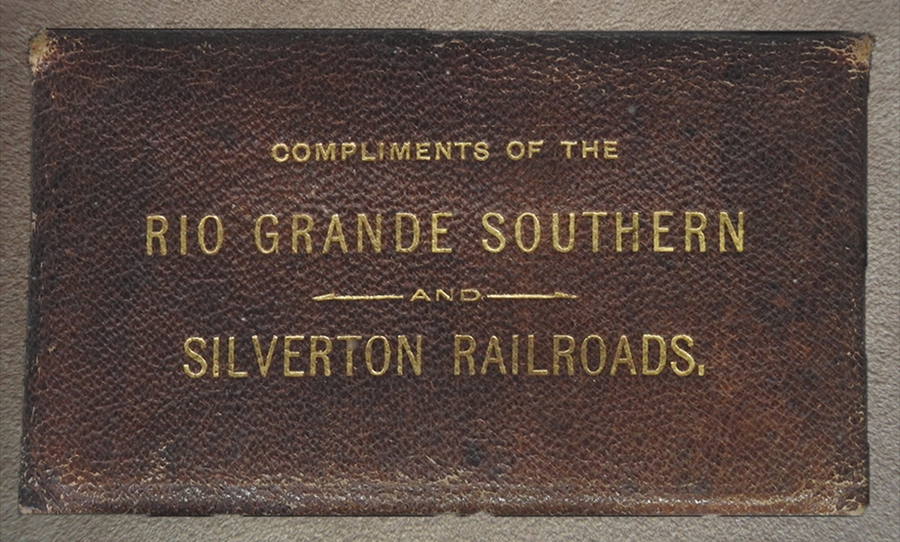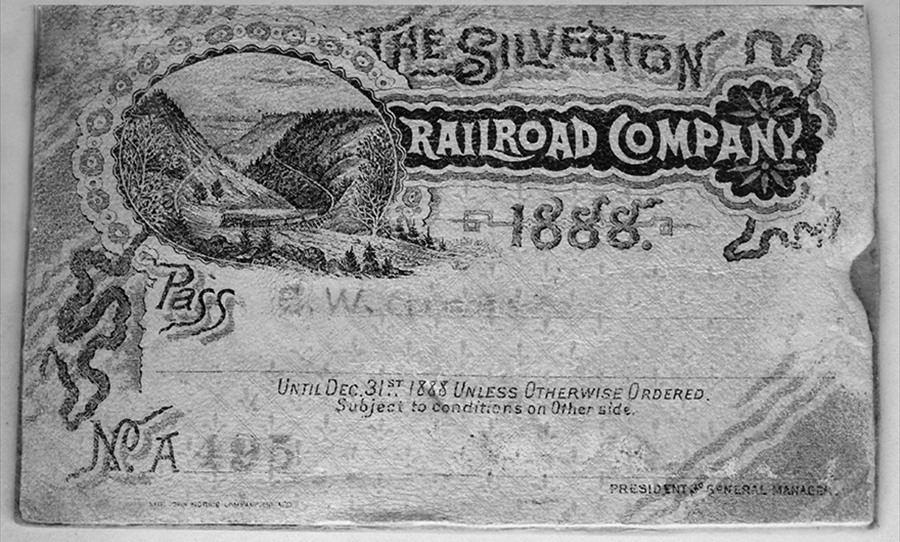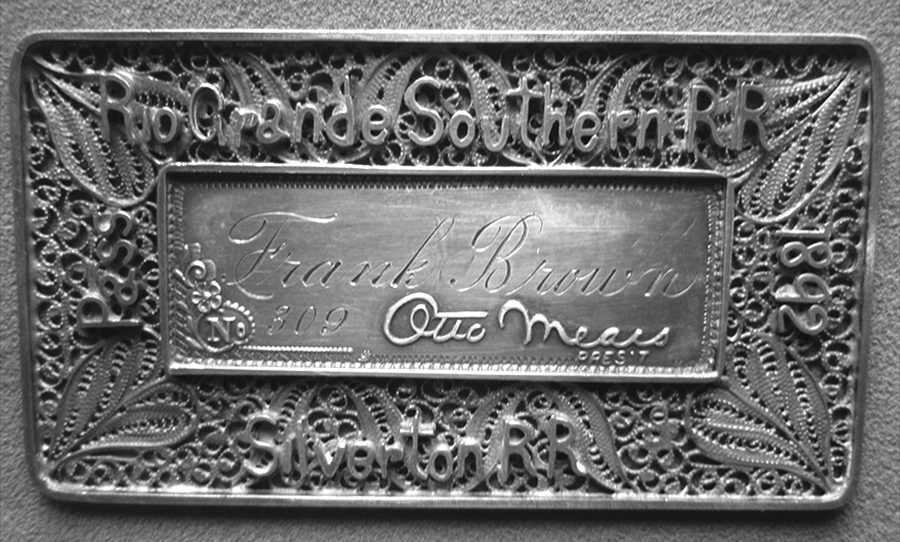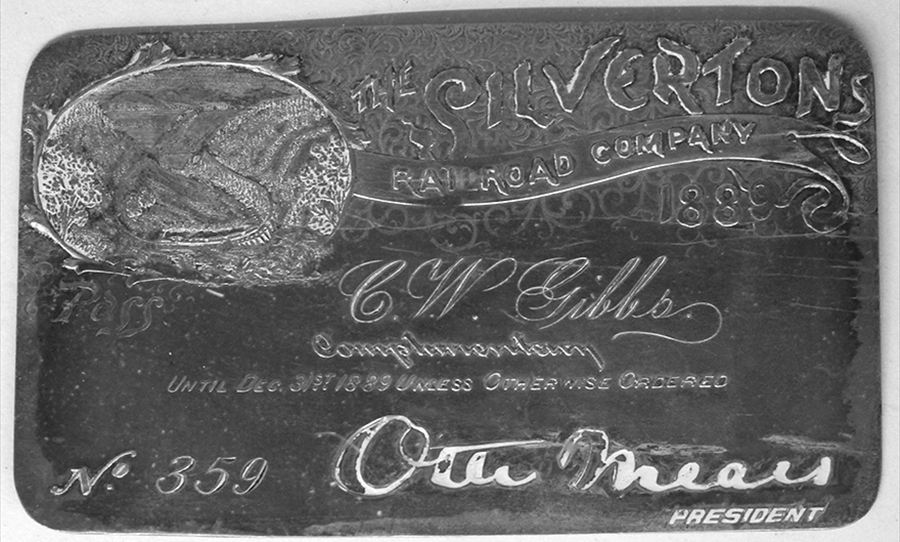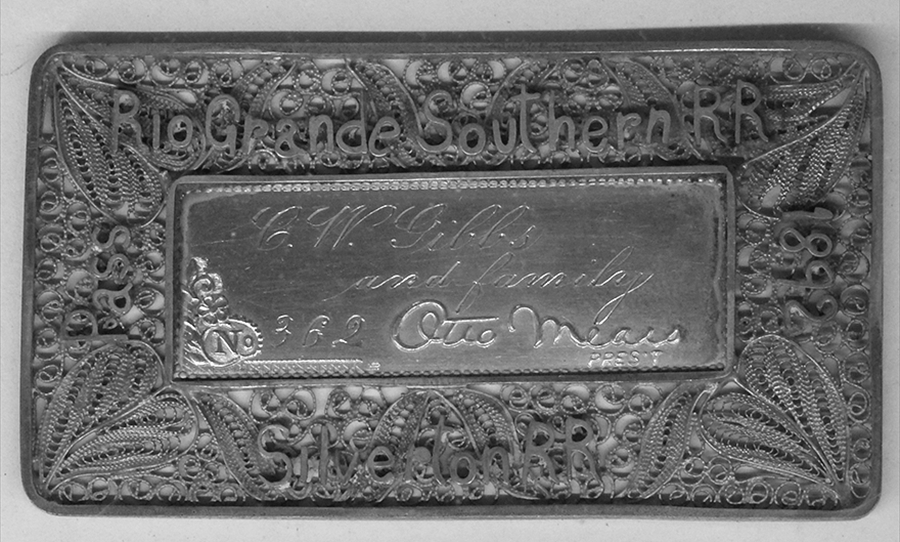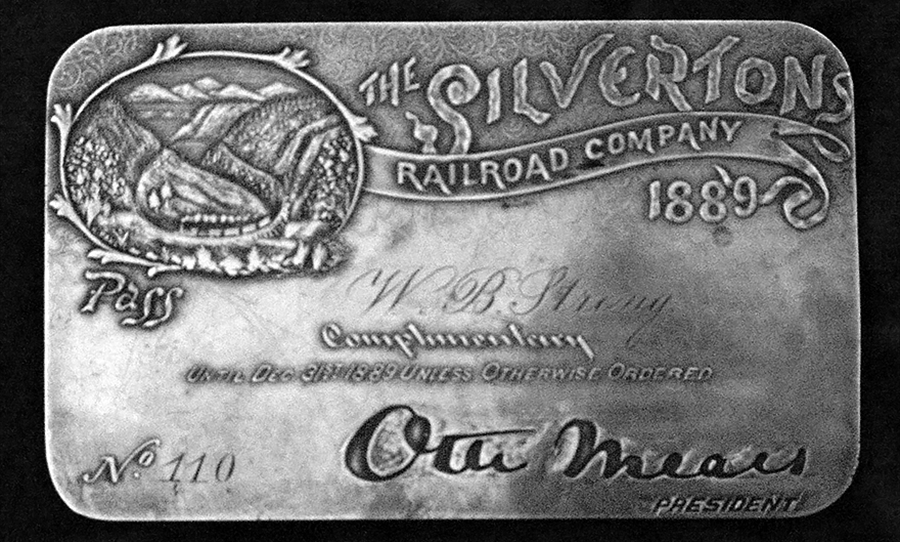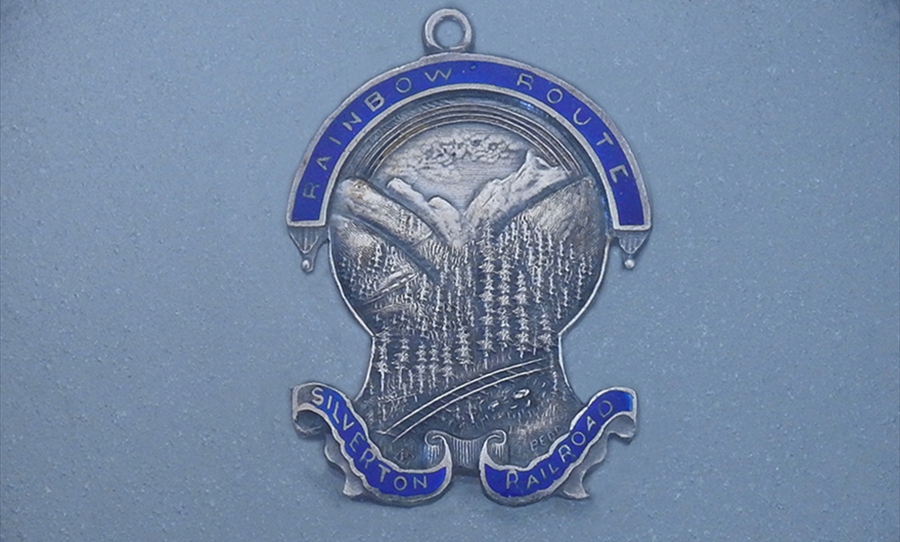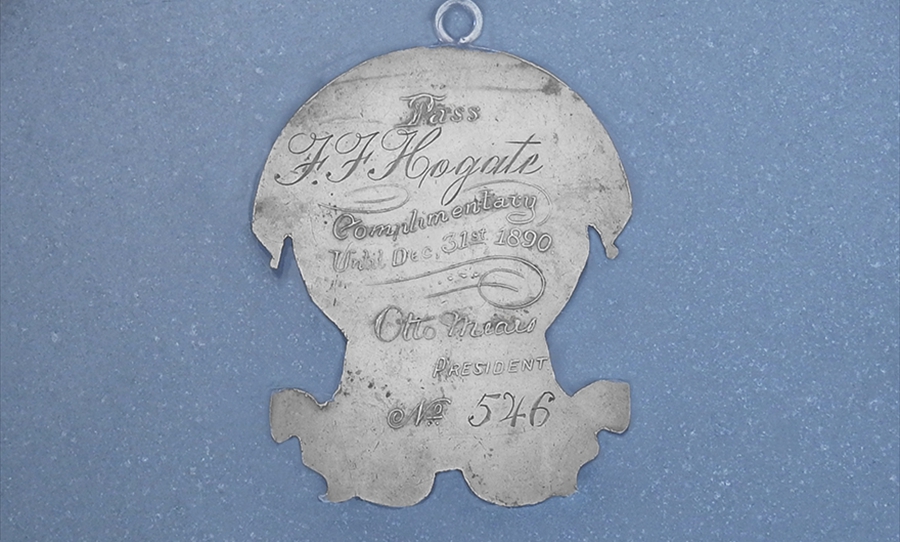
NOTICE: We have lost a good railroad friend with the passing of Bill Strong on February 10th, 2021. Bill was eighty-five when the Coronavirus took his life. He was able to die at home after being in the hospital on a ventilator for a period of time. Bill's wife, Jo, was able to be with him at the end. The obituary that appeared in the Arizona Republican is attached:
"Bill was a lawyer, who came to railroading later in his life. Bill's great grandfather was William Barstow Strong, General Manager and later President of the AT&SF Railroad in the 1870s, 1880s and early 1890s. Bill was named after his great grandfather.
The railroad passes issued by Otto Mears fascinated Bill. Much had been written about the buckskin and silver passes issued by Mears, much of it wrong. Bill decided to correct what had been written and update the known passes. To this end, he wrote, The Remarkable Passes of Otto Mears, by William K. Strong, published in 1988 by the Silverton Standard and The Miner, Silverton, Colorado. In this paperback book, Bill listed all the known silver and leather passes issued to that point by Mears. As more passes became known, Bill issued updates with additional passes in the second printing in 1996 and the third printing in 2007. Bill continued to keep track of passes that were sold by auction houses and on eBay. Collectors also informed him of more passes. As more copies of the third addition were sold at later dates, Bill included inserts with the additional passes discovered".
I, Cres Fleming wrote an article in 2013 updating the Mears passes (The Railroadiana Express, Spring, 2013, p. 6-11). In this update, I revealed a new class of 1893 filigree passes and proposed that the passes had been issued with sequential numbers. Bill contacted me immediately and thus began a friendship that lasted until his death. In 2017, Bill asked me to continue updating the list of known Mears passes. I, then computerized all the known Mears passes. Further, Bill arranged to have the updated computerized list of passes be available on the San Juan County Historical Society's website, maintained by Casey Carroll. Bill wrote a summary of Mears, issuing his passes that was also put on the website along with my 2013 RCAI article. As new Mears passes emerge, I, with the help of Casey, will update the list on known Mears Passes.
This Webpage is a testimonial to Bill's long interest in Silverton and the Mears passes. If you become aware of any new Mears passes, please contact CresFleming44@gmail.com or casey@silvertonwebworks.com. Bill would want that.
OTTO MEARS, PATHFINDER
By William K. Strong
(Click on images to enlarge)
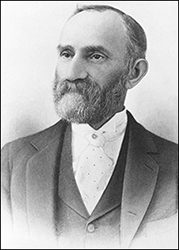
Any information about Otto Mears' unusual buckskin, silver and gold railroad passes for the Silverton Railroad and the Rio Grande Southern R.R. must begin with the background of this remarkable man.
Otto Mears was born in Russia of an English father and a Russian mother in 1840. After being orphaned at an early age he lived with his maternal uncle's large family in Russia until going to live in England with his father's relatives for two years to the age of 11. Perhaps he did not get along with his English relatives. They shipped him off to New York to live with yet another relative. He stayed a year there before being sent to San Francisco to live with an uncle. By the time he arrived, that uncle had left for Australia. The rest of his upbringing was by a woman that befriended him on the ship in the long passage from New York (via horse over the Isthmus of Panama) to San Francisco.
Otto, at most 13 years old, earned his keep by working in a store, for newspapers, by selling ice cream, as a paper boy, and even working as a tinsmith. At the outbreak of the Civil War, he enlisted in the California Volunteers in August, 1861. Following three years of service in New Mexico, he was discharged at Las Cruces.
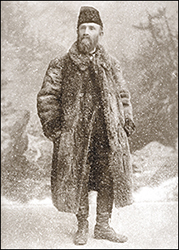 After he worked for his first civilian employers in Santa Fe for six months, they financed him in starting a general store. The first was in Santa Fe, the next in Conejos, Colorado, and the third in Saguache, Colorado, about 1866. There he became a civic leader and involved in lumbering and wheat farming. This led to him becoming active in Colorado politics and the transportation industry.
After he worked for his first civilian employers in Santa Fe for six months, they financed him in starting a general store. The first was in Santa Fe, the next in Conejos, Colorado, and the third in Saguache, Colorado, about 1866. There he became a civic leader and involved in lumbering and wheat farming. This led to him becoming active in Colorado politics and the transportation industry.
Otto Mears needed a dependable way to carry the wheat grown in Saguache area to market in the Arkansas Valley north of Saguache. Since there was none, he got a charter from the Territory of Colorado to build a wagon toll road over Poncha Pass to reach the Arkansas Valley. The Poncha Pass Wagon Road Company was financed with investors capital, and its construction began in 1870.
The financial success of his first toll road led him to set up other toll road companies. The toll roads he founded grew to over 200 miles through the mountains of southwestern Colorado — from Saguache to Lake City. Gunnison, Ouray, Telluride to Silverton and over Marshall Pass, Dallas Divide and Red Mountain Pass, among others. Those around Silverton and Ouray were nicknamed, "The Rainbow Route". The name was later applied to the Silverton Railroad.
Mr. Mears organized the Silverton Railroad Company in 1887 (about 25 miles long when completed) and the Rio Grande Southern Railroad in 1890 (162 miles long when completed). He later was involved in four other railroads and several other businesses. In addition, he was active in Colorado politics for many years. but preferred not to run for office himself. He passed in Pasadena, California in 1931, at age 91.
More information on the life of this unique man in Colorado History is found in Otto Mears: Paradoxical Pathfinder by Michael Kaplan, San Juan County Book Company, Silverton Colorado 1982 and in Otto Mears and the San Juans by E. F. Tucker, Western Refections Publishing Company, Montrose Colorado 2003. You may also find this book for sale in our Mining Hertitage Center Gift Store.
A detailed history of the Mears passes is in The Remarkable Railroad Passes of Otto Mears, William K. Strong, San Juan County Book Company, 1988. Its third printing is by Packrat Publishing in 2007. It remains in print through Fetch's Mining & Mercantile, Silverton, CO. The book usually can be purchased on EBAY.
The book contained lists of Otto Mears unusual passes. Many more have come to light since.
The Master List below is of all Mears unusual annual passes for the Silverton Railroad and for the Rio Grande Southern Railroad presently known to exist prepared by Cres Fleming. If there are any discrepancies between the information below and the information on the pass itself, blame it on human frailties or the challenge in reading old-fashioned script.
Please share any information of passes which are not on the Master List with Cres Fleming: 970-375-2404/hcfleming@frontier.net, so he may verify them and add them to the Master List. Also, please send information about the identity of pass recipients to him.
The set of four Mears passes issued to Charles W Gibbs (1888 no. A495, 1889 no. 359 , 189, no 64, and 1892 no. 362) are on display at the San Juan County Historical Society Mining Heritage Center in Silverton.
AN UPDATE OF OTTO MEARS' FAMOUS PASSES
By Cres Fleming
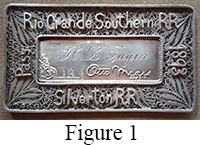
Most railroad memorabilia collectors are aware of the various kinds of railroad passes for the Rio Grande Southern Railroad and Silverton Railroad that were issued by Otto Mears. His leather passes (1888), stamped silver passes (1889), silver watch fob passes (1890) for the Silverton Railroad and silver filigree passes (1892) for the Rio Grande Southern/Silverton Railroads set new standards in promoting railroads. These passes are highly sought by collectors. In this article, I will document a new class of 1893 silver filigree passes, disclose my research on the 1892 and 1893 silver filigree passes (including who provided the leather cases for the passes, who engraved the passes, why there are so few 1893 passes, etc.), update the list of known Mears passes, and finally speculate on the number of passes issued each year.
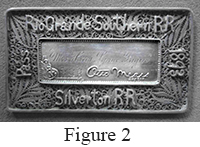
I recently acquired two silver filigree passes (Figures 1 and 2). But these had the dates 1893 on the passes, not the normal 1892. I have never seen an 1893 silver filigree pass or even a photo of one. The names on the passes were HL Fagin (#594) and Mrs. Harry Lynne Fagin (#598). I have written another article about the Fagin (Cres Fleming, Colorado Midland Quarterly, No. 129, November 2012, pp. 9-12). These two passes are unusual for Mears passes in that a husband and wife each received a pass in the same year. With the possible exception of the Burns 1892 passes (Mrs. JJ Burns #16 and an unknown numbered pass made out to John Burns) no other husband and wife received separate Mears passes in the same year as far as we know.
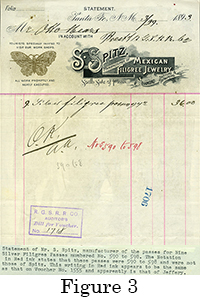 I became intrigued about the 1893 silver filigree passes and decided to research the Mears' passes. This research was conducted in the RGS archives at the Delany Library, Center of Southwest Studies, Fort Lewis College, Durango Colorado.
I became intrigued about the 1893 silver filigree passes and decided to research the Mears' passes. This research was conducted in the RGS archives at the Delany Library, Center of Southwest Studies, Fort Lewis College, Durango Colorado.
Twenty four years ago, Bill Strong wrote the definitive work on the Mears' passes (The Remarkable Railroad Passes of Otto Mears, William K. Strong, San Juan County Book Company, 1988). Previous discussions about these passes are in Sloan and Skowronski's book (The Rainbow Route, Robert E. Sloan and Carl A. Skowronski, Sundance Publications, 1975, p 54, 122-123), Ferrell's book (Silver San Juan: The Rio Grande Southern, Mallory Hope Ferrell, Pruett Publishing Company, 1973, pp. 574-577) and Crum's book (The Rio Grande Southern Story, Josie Moore Crum, 1957, Hamilton Press, pp. 27-9). In his book, under "Other Silver Passes", Bill Strong makes brief mention of two 1893 filigree passes: "Two 1892-type filigree passes bear the year 1893". He lists these as #590 - Dr. & Mrs. E.J. Kinney and #606 - Geo. W. Ristine. Nothing else is said about these passes and they seem to be treated as one-of-a-kind.
1893 Silver Filigree Passes:
In my research at the Delany Library, I reviewed the available RGS vouchers and supporting materials for 1892 and 1893. The RGS paid suppliers using these vouchers. Figure 3 shows a bill dated March 29, 1893 from S. Spitz of Santa Fe NM for 9 silver filigree passes. Someone has penned in Nos. 590 to 598.
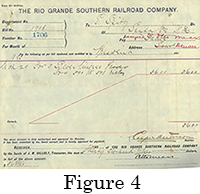 This figure and subsequent figures 4-9 of documents from the RGS collection are used with the permission of the Center of Southwest Studies, Fort Lewis College - M019 Rio Grande Southern Railroad Records. Each silver filigree pass cost $4.00. Figure 4 shows voucher 1706 to pay for the nine passes. Figure 5 shows voucher #1940 to pay for the engraving of pass #594 (HL Fagin pass). The Elgan Banknote Company of Denver engraved the pass. Here we have conclusive proof that these 1893 silver filigree passes were ordered by Mears, produced by S. Spitz (who also made all of the 1892 filigree passes), engraved by Elgan in Denver and issued. We know that at least nine 1893 silver filigree passes were made (Nos. 590-598). Since #606 is also a known 1893 filigree pass, it is safe to assume there were at least 17 of these passes (Nos. 590-606). I could find no records of passes higher than #598 being bought from Spitz. The last voucher for engraving 1893 passes was #2099 on June 16 for pass number #595 (no name shown).
This figure and subsequent figures 4-9 of documents from the RGS collection are used with the permission of the Center of Southwest Studies, Fort Lewis College - M019 Rio Grande Southern Railroad Records. Each silver filigree pass cost $4.00. Figure 4 shows voucher 1706 to pay for the nine passes. Figure 5 shows voucher #1940 to pay for the engraving of pass #594 (HL Fagin pass). The Elgan Banknote Company of Denver engraved the pass. Here we have conclusive proof that these 1893 silver filigree passes were ordered by Mears, produced by S. Spitz (who also made all of the 1892 filigree passes), engraved by Elgan in Denver and issued. We know that at least nine 1893 silver filigree passes were made (Nos. 590-598). Since #606 is also a known 1893 filigree pass, it is safe to assume there were at least 17 of these passes (Nos. 590-606). I could find no records of passes higher than #598 being bought from Spitz. The last voucher for engraving 1893 passes was #2099 on June 16 for pass number #595 (no name shown).
The unanswerable question is, when did Mears stop issuing 1892 filigree passes and start issuing the 1893 filigree passes? RGS vouchers to Spitz for providing passes late in 1892 are: V1014 (Nov 9 for 7 passes) and V1224 (Dec 28 for 5 passes). [Note: V1014 indicates there is a voucher (#1014) dated November 9, 1892 in the RGS archives at Delany Library. This nomenclature will be used for the remainder of the article.] Every voucher to Spitz after these specifies the number on the passes supplied. V1407 specifies pass #586 provided on Jan 2, 1893 and pass #587 provided on Jan 6, 1893. V1505 shows pass #588 provided on Feb 10. The next voucher is the aforementioned V1706 for passes #590-598. In the archives there is no record of pass #589.
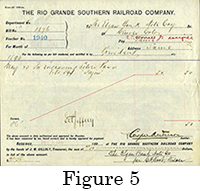 For reasons stated in the next section, I believe Spitz supplied 1892 passes (total of 582) through voucher 1224. The 1893 filigree passes probably start with pass #586 since there is a clear break in how Spitz billed the RGS (from the vouchers written). Until lower numbered passes surface (below #590) to show what are 1892 passes and 1893 passes, we cannot say with certainty.
For reasons stated in the next section, I believe Spitz supplied 1892 passes (total of 582) through voucher 1224. The 1893 filigree passes probably start with pass #586 since there is a clear break in how Spitz billed the RGS (from the vouchers written). Until lower numbered passes surface (below #590) to show what are 1892 passes and 1893 passes, we cannot say with certainty.
The numbering of the 1893 passes appears sequential to the 1892 passes. Elgan Engraving Company (who changed their name to Elgan Bank Note Company around November 1892) submitted vouchers for engraving passes on the following dates: 23 passes on July 15, 1892 (V #158); 1 pass on Oct 6, 1892 and 1 pass for J. Ralph on Oct 11, 1892 (V #823); 6 passes in November, 1892 (V #1013); 1 pass (#586) on Jan 2, 1893 and 1 pass (#587) on Jan 6, 1893 (V #1407); 1 pass #588 for Haynes (V #1551) on Feb 10, 1893; one pass #592 for Burton on Mar 31, 1893 (V #1678); the pass for Fagin #594 on May 23, 1893, and finally one pass for #595 (no name) on June 16, 1893 (V #2099). Again it is not clear when Mears stopped having 1892 passes engraved and started having 1893 passes engraved. The highest numbered pass known to be an 1892 filigree pass is #578 given to Adelaide G. Stimpson (Strong book).
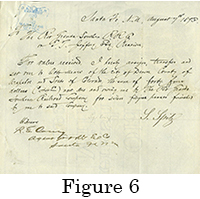
We have no invoices for engraving after pass #595 and we have no invoices for manufacturing filigree passes after #598. Yet we have engraved passes for #598 and #606. Certainly missing records could account for this. But there may be another reason. In 1893 the RGS (and other railroads) was hit by the Panic of 1893, the most serious recession the country had seen to that date. Acerbating the panic effects for the RGS was the repeal of the Sherman Act that required the US Government to buy silver. The price of silver plummeted as did the business for the RGS. In short the RGS went bankrupt. E.T. Jeffrey, President of the Denver & Rio Grande, became the Receiver for the RGS on August 2, 1893. In this capacity he was to steer the railroad through bankruptcy court. Otto Mears was out as President and General Manager.
It would be unseemly for a bankrupt railroad to be handing out expensive silver passes ($4.00 each plus $0.50 to engrave) while undergoing bankruptcy proceedings. The filigree passes for 1892 had cost the RGS at least $2,600. This was over 3 months of pay for President and General Manager Otto Mears ($833.33 salary per month - data from monthly vouchers used to pay Mears). Jeffrey wanted to end this expensive pass program. In Figure 4 you can see that the line 'Pay" where it says "Same" (for S. Spitz) has been crossed out and "assigned to Otto Mears" has been penned in. In Figure 5 the payment for the engraving of the HL Fagin pass has been assigned to ES Worrell. These assignments are at first puzzling.
Figure 6 shows a letter from S. Spitz to Jeffrey requesting the money owed to him by the RGS be paid to Mears. Figure 7 is a typed translation of Figure 6. I had at first thought Jeffrey was trying to get the passes off of the RGS books. In conversation with Bill Strong, Bill came up with the hypothesis that Mears was protecting Spitz. Bill believes that, because the assignment is dated 5 days after the date Jeffrey was appointed as the bankruptcy receiver of the RGS, Mears paid Spitz the $44.00 balance of the Spitz receivable from the RGS and had Spitz assign the receivable to him.
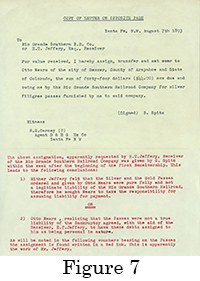 Mears probably wanted to keep doing business with Spitz. Mears had leftover 1893 passes at the time of bankruptcy (#596-598) and he continued issuing them on his personal account. We have no record of how many additional 1893 passes were purchased from Spitz, engraved by Elgan and sent to clients. We know that at least 8 more 1893 filigree passes were obtained from Spitz as pass #606 exists. There may be higher numbers that have not surfaced yet.
Mears probably wanted to keep doing business with Spitz. Mears had leftover 1893 passes at the time of bankruptcy (#596-598) and he continued issuing them on his personal account. We have no record of how many additional 1893 passes were purchased from Spitz, engraved by Elgan and sent to clients. We know that at least 8 more 1893 filigree passes were obtained from Spitz as pass #606 exists. There may be higher numbers that have not surfaced yet.
In Bill Strong's book there is a picture of one of three unissued 1893 stamped silver passes for the Silverton Railroad. These passes combine elements of the 1889 stamped pass, the 1890 watch fob pass and the 1892-3 filigree pass. I believe after Mears was forced out of the RGS he wanted to continue issuing silver passes to friends and movers and shakers. When he had exhausted his supply of 1893 RGS/SRR filigree passes he planned to start issuing silver passes from the Silverton Railroad. These less costly stamped silver passes probably were the victims of the deepening recession gripping the US as the year went on. Hence, none were ever issued to our knowledge.
To summarize, there were at least seventeen 1893 silver filigree passes issued (but to date only four are known to exist). This number made could be significantly higher if Mears issued engraved 1893 passes late in 1892. It is clear, passes were being engraved throughout each year and sent to friends and clients. This many 1893 silver passes demonstrate that they constitute a separate class of Mears passes.
1892 Silver Filigree Passes:
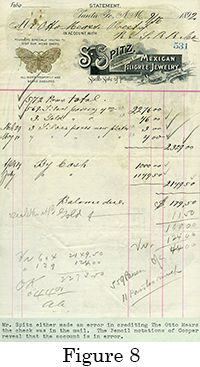
My research has added several tidbits of information about the 1892 passes. Spitz sent a statement (Figure 8) for 1892 passes to the RGS on September 16, 1892 where he indicated he had supplied 569 silver filigree passes, 3 gold filigree passes, and 7 plates (presumably to replace the center piece of the filigree passes that had engraving errors or other problems). Someone has written on the statement "11 passes too much". The RGS vouchers for payment for silver filigree passes result in a different count. Voucher #604 (Figure 9) shows payment for 527 silver filigree passes. Voucher #139 on July 12, 1892 shows 32 silver filigree passes and gives credit for one pass made out to M. Frost. Voucher #531 adds another 11 passes on September 30, 1892. As previously mentioned, there are two more vouchers for silver filigree passes in 1892: V1014 on November 9 for an additional 7 passes and V1224 for 5 passes on December 28. If we assume all of these are 1892 filigree passes, the vouchers total to 582 passes. We have an 1892 pass numbered 578 (Adelaide G. Stimpson). With this pass I believe the number of 1892 filigree passes issued is between 578 and 582. This assumes passes numbered higher than #582 were 1893 passes (such as #586-588 that Elgan billed the RGS for).
The engraver of some of the 1892 and 1893 filigree passes was the Elgan Engraving Company (Elgan Bank Note Company) of Denver. There are only records of their engraving passes after June of 1892. It is not known who engraved the majority of the 1892 passes. Probably the 1892 RGS voucher records are incomplete. There are no 1891 voucher records. The engraving of the numbers on the two Fagin 1893 passes is different than most 1892 passes. The names appear to be in the same font (English script) for both of the 1892 and 1893 passes. Perhaps Spitz was engraving the numbers on the 1893 passes before he sent them to Mears.
The 1892 passes were encased in a leather pouch ( in top slideshow). These pouches were made by Poole brothers in Chicago, IL. In RGS voucher #11 dated February 16, 1892 500 leather pouches were ordered for $75.00 or $0.15 each. An additional 50 pouches were ordered on June 20, 1892 for $10.00 or $0.20 each (V #679). Finally 23 leather pouches were ordered on December 10, 1892 for $4.60 (V #1374). While the latter order may have been intended for the 1893 filigree passes, none of the 1893 passes is known to have come with a pouch. So the pouch numbers indicate that some 1892 filigree passes were not supplied with a pouch.
Number of Mears Passes Issued:
There has been lots of conjecture about how many Mears passes were issued each year. When the early books discussing the passes were written (Ferrell, Crum) there were not many of these passes known.
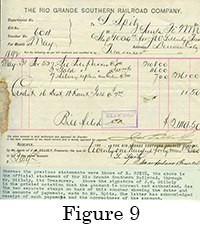 Hence there were large gaps between pass numbers. People tried to guess what kind of a numbering system Mears used due to the sporadic nature of the known numbers. Ferrell even quotes Mears' Chief Clerk at Silverton as saying they used numbers off of ore cars for the passes. I think the Chief Clerk was having fun at Ferrell's expense - a little railroad humor!
Hence there were large gaps between pass numbers. People tried to guess what kind of a numbering system Mears used due to the sporadic nature of the known numbers. Ferrell even quotes Mears' Chief Clerk at Silverton as saying they used numbers off of ore cars for the passes. I think the Chief Clerk was having fun at Ferrell's expense - a little railroad humor!
Where we have documented the approximate number of passes produced (1892 filigree passes) there is no doubt that at least 578 passes were produced and probably issued. This implies the pass numbers for 1892 passes were sequential (numbers 1 to 578 or higher). The pass numbers for the 1893 passes are sequential (certainly numbers 590 - 598) and higher than the 1892 pass numbers. The highest known pass number for the 1888 leather passes is A 495 (C.W. Gibbs). The highest number known for the 1889 stamped silver pass is 634 (W.P. Knapp). The highest number for the 1890 watch fob passes is 571(J.F. Vaile).
In my view, there is no reason NOT to conclude that at least as many passes were issued as the
highest known pass number. If Mears issued over 560 passes in 1892 why wouldn't he have issued about that many in the other years? The reason for the large gaps in the pass numbers each year depended on the numbers that have survived. The 1888 leather passes (or buckskin as they are called - more on this later) were the most fragile and hence were least likely to survive. This coupled with their being made out of a relatively worthless material results in the 1888 passes having the smallest number of known passes to have survived.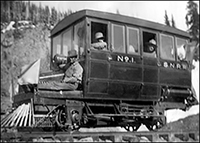 Only 25 are known to have survived. Watch fobs went out of style in the early 1920s when wrist watches became popular. Who would keep them? The blue enamel face is easily chipped and the writing on the back is difficult to read. I suspect many of these were tossed due to people not knowing what they were. Only 51 are known to have survived. The stamped metal 1889 passes were legible and made out of silver. They looked like a pass and hence more of them would be kept by relatives and passed down. 92 of these have survived. The 1892 silver filigree passes are like jewelry. I suspect that is why they are the most likely to survive. 108 of these survived. To think Mears had a funky pass numbering scheme based on the numbers of passing ore cars or any other quirky procedure boggles the mind. In all probability, all the Mears passes were consecutively numbered from 1 to the highest number issued.
Only 25 are known to have survived. Watch fobs went out of style in the early 1920s when wrist watches became popular. Who would keep them? The blue enamel face is easily chipped and the writing on the back is difficult to read. I suspect many of these were tossed due to people not knowing what they were. Only 51 are known to have survived. The stamped metal 1889 passes were legible and made out of silver. They looked like a pass and hence more of them would be kept by relatives and passed down. 92 of these have survived. The 1892 silver filigree passes are like jewelry. I suspect that is why they are the most likely to survive. 108 of these survived. To think Mears had a funky pass numbering scheme based on the numbers of passing ore cars or any other quirky procedure boggles the mind. In all probability, all the Mears passes were consecutively numbered from 1 to the highest number issued.
Other Items:
The 1888, the Mears leather pass has been described as made from buckskin (made from deer - Strong and Sloan/Skowronski) or sheepskin (Ferrell) or cowhide (Strong). So we don't know what it is made from. I ask that someone take a small piece of their 1888 pass and have a cheap DNA test done on the material to decide once and for all if they are made from deer, sheep or cows. My money is on the cows as it would be the cheapest material and most readily available.
Several passes have surfaced that are not yet in Bill's lists. Frank Polzin kindly shared the following information on recently surfaced passes. Additional 1889 passes to Bill's list are: #261 (T.L. Drake - Type A), #289 (J.C. Kennedy - type A) and #617 (Corwell - type B). Two additional 1892 filigree passes are: #4 (Mrs. J.W. Gilluly, who was wife of the RGS Treasurer) and #570 (J.L. Pilsbee).
Conclusions:
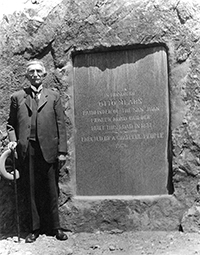
Hopefully, I have convinced you that Mears issued a significant number of 1893 silver filigree passes (at least seventeen) numbered sequentially and with numbers higher than where the 1892 filigree pass numbers ended. These 1893 passes constitute a new category of Mears passes. Second the provider of the leather pouches (Poole Brothers of Chicago) and the engraver (Elgan Engraving/Elgan Bank Note Company of Denver) of some of the 1892 and 1893 passes were disclosed. These passes were issued throughout the 1892 and 1893 years, not issued only at the start of the year. It was proposed that Mears used a normal sequential numbering system for all his passes and the number of passes issued each year was significantly higher than has been accepted before by earlier authors. The number of known surviving passes for each year was given and a rationale for these proposed. Finally it was argued that Mears had to continue issuing silver passes for his own account after the RGS went into receivership under E.T. Jeffrey in August, 1893. Clearly much has become known about Otto Mears' passes in the last 24 years. I suspect more will become known in the coming years to enhance our knowledge about these wonderful passes.
If you have any comments about this article, please contact Cres Fleming at (970) 375-2404 or at hcfleming@frontier.net.
Acknowledgements:
I want to thank Jen Pack and Peekay Briggs of the Delany Southwest Library and Archives at the Center of Southwest Studies. The Delany Research Library and Archives contains a wonderful resource on the Rio Grande Southern Railroad as well as other railroad resources such as the John Hubbard 30,000 railroad photographic collection of Colorado railroads. Also, Bill Strong has made many contributions to this article and I gratefully acknowledge his assistance. Finally, thanks are due to Frank Polzin, Dan Richins and Brad Lomazzi for their assistance.

